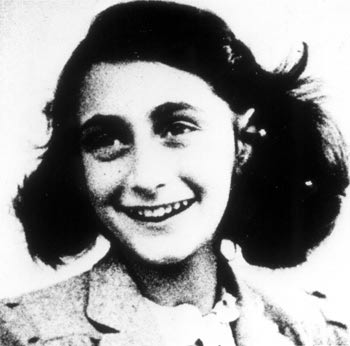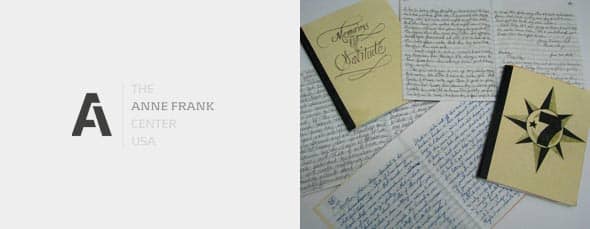by Maureen McNeil
Anne Frank wrote that when society fails to protect its people, it’s not just the politicians who are to blame, but the common people. Unfortunately, societies around the world continue to fail in that regard today, 60 years later.

The Anne Frank Center USA addresses this issue by creating educational programs and exhibits to teach literacy, tolerance, character-building, culture, emotional intelligence and resiliency with Anne Frank as the role model. At the heart of every program is reading Anne’s diary and diary writing.
One must practice freedom to be free. And diary writing can be used as an exercise in freedom. Whether private or shared, a diary is a symbol of empowerment.
Anne Frank’s diary, written from 1942 to 1944 during her family’s years in hiding from Nazi occupiers in the Netherlands, proves she existed. The diary proves the Holocaust happened and it was used in court of law during the Nuremberg Trials on war crimes. And it proves that writing, with practice, can become a legitimate power.
Anne’s arc of self-discovery maps the creative process humans undergo as they become independent thinkers. What we learn is that each of us can determine at every moment if we are helpers, perpetrators, victims, bystanders or resisters.
Anne’s diary is now available to help contemporary students, artists, incarcerated youth, prisoners and everyday citizens engage in the process of self-reflection and find their connections to others.
Words Reverberate Through Prison Walls
In keeping her diary, Anne resisted her role as victim. She was determined to be a writer or journalist when she heard on the radio that the Dutch government would be collecting letters and diaries after the war. Suddenly she had an audience, and she sat down and rewrote her diary in three weeks in a higher literary style.
Anne resented being treated like the “baby” in the secret annex and struggled fiercely for her right to work at the desk in the bedroom she shared with Fritz Pfeffer, the dentist in hiding with her family. She ignored her parents’ concern that she spent too much time alone in the attic with Peter, the son of the family that shared the secret annex. Freedom and responsibility was the philosophical framework she chose to live by; reward and punishment would not contain her. She said as much in a letter to her father, and he was crushed. At the end of her diary she said that self-knowledge was her most important accomplishment. The lesson we as readers take away is that we must first understand ourselves before we can understand and be empathic toward the “Other.”

Anne demonstrated how this understanding can work. She wrote on June 13, 1944: “Many people in hospitals and prisons long for the day when they’ll be free to enjoy what nature has to offer. But few are cut off as we are from the joys of nature, which can be shared by rich and poor alike.” Throughout her diary, Anne nurtured herself while deprived of the freedom to walk outdoors. Watching the chestnut tree in the backyard cycle through the seasons offered her hope that, one day, humanity would also have another chance.
Prisoners today are no different. The Prison Diary Project at The Anne Frank Center USA, in partnership with PEN American Center, sends a copy of Anne Frank’s diary, a blank journal and a pamphlet on diary writing with examples over the last 1,000 years.
Prisoners spend up to three months reading, writing, observing and reflecting on their hopes, dreams and fears. They return their diaries to The Anne Frank Center USA for archiving, where excerpts are posted on the website and collected in a booklet for participants. Like Anne’s writing, the descriptions of everyday observations are powerfully human.
“On the walk back to my dorm my thoughts were preoccupied with the smell of the rain storm that’s coming,” wrote Jodi L. Serino from her cell in the Lincoln Correction Center in Lincoln, Illinois. “I finally know how to smell rain. So how would I describe it? What does rain smell like? It smells fresh and green and the air feels soft and moist. I closed my eyes to take in deep breaths while my line was paused to wait for everyone to come out of the chow hall. The sky had a few grey clouds but they didn’t look ominous yet the scent of rain was ever present. I opened my eyes to look at life around me. So many oblivious to the fact that a storm is on the way—ignorant of the signs right before their faces. Such is the way of humans. We ignore the signs until it’s too late.”
The prisoners’ diaries show how profoundly freedom is linked with responsibility. Inmates write about their fear of being released. This is no wonder, as they have been able to exercise neither freedom nor responsibility while in prison.
Most of the participating prisoners fall into two categories. In one grouping are those who don’t know what love is, never were loved and don’t know if they have ever loved anyone. In the other category are those who made a mistake, most often involving drugs. Yet, no matter how long they’ve been imprisoned, they are inspired by Anne’s accomplishments while in hiding and they decide to make good use of their time behind bars.
The goal of the Prison Diary Project is to educate people on both sides of the “wall.” Readers of these diaries cannot help but feel their humanity stretched taut, and, in so doing, like Anne, are able to identify with the “Other,” a lesson that continues to reverberate through time.
A Diary Reaches Out
Other programs similarly reveal how the process of writing – and reading – a diary can reach inside walls of all sorts.
A three-hour film made in 2009 by staff at the Anne Frank Center and edited by Hollywood film editor Bruce Green shows New Yorkers reading their favorite excerpts of Anne Frank’s diary and talking about why they chose their selection. They affirm, again and again, that people read Anne’s diary for the simple human story. She was a daddy’s girl who, through the use of her father’s Leica camera, learned the creative process early, and experienced the difference between her internal and external self. She struggled with her “perfect” older sister Margot who everyone said was prettier, smarter and more demure than Anne. She rejected her mother as a role model—Anne wanted to work outside the home, travel, study art, become a journalist or famous writer. Anne wrote about menstruation, breasts, sex, falling in love and being disappointed in love because the object of her affection, Peter, thought he might become a criminal after the war.
Anne thought no matter how bad our situation in life, it is our responsibility to develop our character. She was also deeply moved by the four helpers, and in her collection of essays and short stories, Tales from the Secret Annex, she writes about a deep desire to give back to the world and to be remembered long after her death—a wish that came true.
| A diary can reach inside walls of all sorts |
Today, quotes from her diary are used in 10-week in-school art projects, enabling students to reflect on how themes in Anne Frank’s life relate to students today. The Anne Frank Center USA also has a theatre program called “Diary 21,” in partnership with Stephen Sondheim’s organization Young Playwrights and the Vineyard Theatre. Students from two very different backgrounds meet with a professional playwright for six weeks and learn about each other by watching their dramatic stories be performed on stage.
Another program, the Anne Frank Project in Harlem, is a collaboration with the nonprofit Behind the Book. Last year four tenth grade classes met with authors Francine Prose and Ishmael Beah, as well as a visual artist. They kept diaries while reading and discussing Anne Frank’s diary. Half of the participating students wrote about the day their father left home and they never saw him again. Their culminating project was a magazine with self-portraits, both visual and verbal, side by side. The presentations highlight the typical teenage feeling that Anne knew so well — that the internal and external selves don’t match, and that one is hiding from the other or putting on a front.
In order to teach students anti-bullying and character development at a young age, the Anne Frank Center USA, Dr. Janet Kremenitzer from Lehman College and PS 43 in the Bronx have formed a partnership the create an “Emotionally and Academically Smart School through the Art of Self Discovery.” Dr. Kremenitzer has long used Anne Frank as a role model for emotional intelligence with her graduate students. While 3rd through 5th grade students create self-portraits and graphic narrative stories about their own lives, the program will provide professional development for all 65 classroom teachers and is forming a local community advisory committee to help solve problems that range from racism to teacher parking.
A new project is working with volunteer educators on Anne Frank in America, modeled after Anne Frank programs in South America and South Africa. The project uses Anne’s story to ask questions about the way the U.S. culture has seen the “Other” throughout history, from slavery and segregation to the Native American reservation system and Japanese internment.
Anne Frank’s simple volume continues to open doors around the world to the lessons of hope that were learned so well during her 26 months hiding from the Nazis. As bombs fell on Amsterdam, as burglars broke into the secret annex in search of food, as Nazis hunted for Jews, Anne learned to focus on the freedoms and responsibilities of being a better human being.
Maureen McNeil is a writer and arts educator, currently the Director of Education at Anne Frank Center USA where she creates programs on literacy and tolerance inspired by Anne Frank’s diary. She was previously the Director of The Lee Strasberg Theatre and Film Institute, and also has worked museum education, publishing and as a writing instructor in schools. A collection, “Red Hook Stories,” about the Brooklyn neighborhood in the 1980s, came out in 2008, and her poetry and stories have been published in journals such as Woodstock Times, Home Planet News, Mothering Magazine and The Literary Review. The Anne Frank Center is located in New York City.
Also see Equality for Women: Insights from My Grandfather by Maame-Mensima Horne in this edition of On The Issues Magazine.
See The Poet’s Eye in this edition of On The Issues Magazine.
Visit The Café of On The Issues Magazine for new stories and
